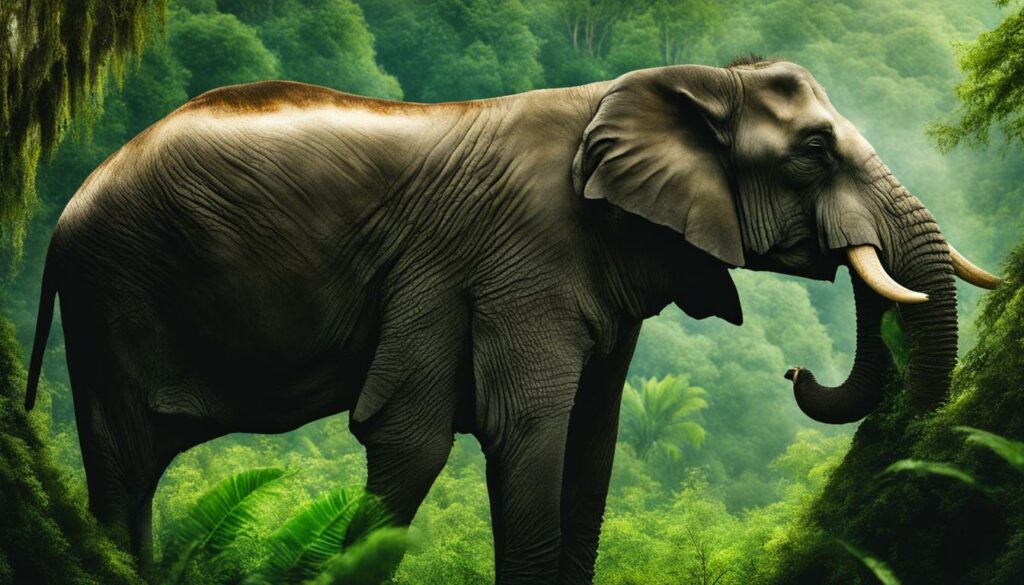If you’ve ever been captivated by the gentle nature and grandeur of elephants, you’re not alone. These magnificent creatures have a lot more to offer than meets the eye. From their massive size to their exceptional intelligence, elephants are truly remarkable beings that deserve our attention and admiration. In this article, we’ll explore some fascinating elephant facts that will surely leave you in awe. So, let’s dive in and discover the incredible world of elephants!
Did you know that elephants are the largest land mammals on Earth? African elephants can reach heights of up to 13 feet and weigh more than six and a half tons. Asian elephants are no small fry either, standing over 11 feet tall and weighing up to six tons. These gentle giants have a lifespan of 60 to 70 years, and they possess the largest brains among land mammals, making them highly intelligent creatures.
But that’s not all! Elephants are also known for their remarkable memory. They can recall specific details even after many years and use their memory to navigate long distances, find food and water sources, and recognize other elephants and humans. In fact, their memory is so impressive that they can even distinguish different languages and mimic words in human languages.
Elephants have a unique way of communicating with each other as well. They produce a variety of vocalizations, including low-frequency rumbles that can travel over long distances. These rumbles help elephants communicate and express their emotions. In addition, elephants have an extraordinary sense of hearing and can detect infrasonic messages through their sensitive feet and trunks.
Did you know that elephants love playing in the water? They are excellent swimmers and enjoy splashing and showering themselves and others with their trunks. They even use their trunks as snorkels when crossing deep water. Playing in the water not only helps elephants cool down but also protects their sensitive skin from the sun. It’s their way of having fun and socializing!
One of the most fascinating aspects of elephants is their strong sense of empathy and social structure. They form tight-knit family units led by matriarchs, who pass down essential knowledge and information to the younger generations. Spending time with older family members is crucial for young elephants to learn vital skills for adulthood. Unfortunately, elephants are at risk due to poaching and habitat loss, making conservation efforts more important than ever.
These are just a few of the many incredible facts about elephants. Their gentle nature, intelligence, and complex social behaviors continue to captivate our hearts and remind us of the need to protect these magnificent creatures. Join us as we explore more fascinating facts about elephants in the upcoming sections of this article!
African Elephants vs. Asian Elephants
When it comes to elephants, there are two main species that capture our attention: African elephants and Asian elephants. While they share some similarities, they also have distinct differences that make each species unique.
Size and Appearance: African elephants are the largest land mammals, towering over their Asian counterparts. They can grow up to 13 feet tall and weigh over six and a half tons. African elephants are known for their large ears, while Asian elephants have smaller ears shaped like the continent of India. Additionally, female Asian elephants have small tusks called tushes, while only male Asian elephants have large tusks.
Social Behavior: Both African and Asian elephants exhibit highly intelligent and social behaviors. However, they have different social structures. In African elephants, the social structure is matriarchal, with the eldest female leading the group. Asian elephants, on the other hand, have a less hierarchical social structure and show less dominance based on age or gender.
Conservation Status: Both species of elephants are at risk due to various human activities such as poaching and habitat loss. African elephants, in particular, face significant threats due to the demand for ivory. Conservation efforts play a crucial role in protecting these majestic creatures and ensuring their survival for future generations.
| African Elephants | Asian Elephants | |
|---|---|---|
| Size | Up to 13 feet tall and over six and a half tons | Smaller than African elephants, reaching up to 9 feet tall and weighing up to five tons |
| Social Structure | Matriarchal with eldest female leading the group | Less hierarchical social structure |
| Tusks | Both males and females have large tusks | Only males have large tusks, females have small tusks called tushes |
| Conservation Status | Threatened due to poaching and habitat loss | Vulnerable due to habitat loss and human-elephant conflict |
The Incredible Abilities of Elephants
Elephants possess a wide range of incredible abilities that set them apart from other animals. One of their most remarkable traits is their exceptional memory. Elephants can recall specific details even after many years, using this memory to locate distant watering holes, recognize other elephants and humans, and find sources of food and water over long distances.
Not only do elephants have a remarkable memory, but they also have a deep understanding of human communication. They can distinguish between different voices, recognizing friends from potential threats. In fact, some elephants have even been known to mimic words in human languages, showcasing their extraordinary language skills.
Elephants are highly intelligent creatures who exhibit complex social behaviors and empathy. They demonstrate compassion by consoling distressed individuals and engaging in coordinated helping behaviors. However, they are also deeply affected by traumatic experiences, showing signs of post-traumatic stress disorder.
Incredible Elephant Abilities at a Glance
| Abilities | Descriptions |
|---|---|
| Memory | Elephants possess a legendary memory, recalling specific details even after many years. They use this memory to locate distant watering holes, recognize other elephants and humans, and find sources of food and water over long distances. |
| Language Skills | Elephants have a deep understanding of human communication and can recognize different voices. Some elephants have even been known to mimic words in human languages, showcasing their remarkable language skills. |
| Empathy | Elephants exhibit complex social behaviors and empathy. They console distressed individuals and engage in coordinated helping behaviors, demonstrating their capacity for compassion. |
| Post-Traumatic Stress | Elephants are deeply affected by traumatic experiences and can show signs of post-traumatic stress disorder. This underscores their emotional intelligence and sensitivity. |
“Elephants are nature’s gentle giants, their incredible abilities continue to amaze and inspire us.”
The Fascinating Communication of Elephants
Elephants have a unique and intricate communication system that involves a combination of vocalizations, infrasonic messages, and a keen sense of hearing. Their ability to communicate is truly fascinating and sets them apart from many other animals.
One of the most remarkable aspects of elephant communication is their use of low-frequency rumbles. These rumbles can travel long distances and are used to convey various messages among elephants. Whether it’s to signal danger, establish territory, or simply communicate their presence, these low-frequency vocalizations play a crucial role in their social interactions.
But elephants’ communication skills go beyond vocalizations. They also have an extraordinary sense of hearing, which allows them to pick up infrasonic messages. Elephants can detect these messages through their sensitive feet and trunks, using seismic vibrations to communicate and gather information about their environment.
The Rich Vocabulary of Elephant Vocalizations
Elephants have a wide range of vocalizations at their disposal. Aside from rumbles, they can emit snorts, roars, cries, barks, and even mimic human speech. These vocalizations serve different purposes, helping elephants convey emotions, establish dominance, or warn others of potential threats. They are a crucial part of their complex social structure and help maintain cohesion within elephant herds.
“Elephants have the incredible ability to understand human communication. They respond differently to the voices of different groups, showing heightened awareness and defensive behaviors when they hear voices of groups they fear.”
The Remarkable Empathy and Awareness of Elephants
Their exceptional communication skills also extend to their interactions with humans. Research has shown that elephants can understand human communication and respond accordingly. They can distinguish between different voices, recognizing friends from potential threats. This heightened awareness demonstrates their remarkable ability to comprehend and adapt to their environment.
Understanding the intricate communication of elephants allows us to gain insight into their social dynamics and behavior. It reminds us of the fascinating complexity of the animal kingdom and the importance of preserving these incredible creatures and their unique communication systems.

The Playful Side of Elephants
Despite their massive size, elephants have a playful side that brings joy to both observers and fellow elephants. One of their favorite activities is playing in the water. They love splashing and showering themselves and their companions using their versatile trunks. Elephants are also excellent swimmers and use their trunks as snorkels when crossing deep water. Watching these gentle giants frolic in the water is a delightful sight that showcases their playful nature.
Not only do elephants enjoy water play, but they also engage in another fun activity: throwing mud or clay on themselves. This behavior serves multiple purposes. Firstly, it acts as a natural sunscreen, protecting their sensitive skin from sunburn. Secondly, it helps elephants cool down in hot weather. The layer of mud or clay acts as a barrier, preventing heat from penetrating their bodies. This playful behavior not only serves practical purposes but also allows elephants to express their playful nature.
“Elephants love to play, and their playful nature is an important aspect of their social interactions,” says elephant conservationist Dr. Jane Jones. “Play helps young elephants learn important skills, such as using their trunks effectively, and it strengthens social bonds within the herd.”
Play is not just a form of entertainment for elephants; it is an essential part of their development. Through play, young elephants learn crucial skills that will help them navigate their environment and survive in the wild. By observing and imitating older elephants, they learn how to use their trunks for gathering food, interacting with others, and even communicating. Play also fosters emotional well-being and a sense of belonging within the herd, promoting social cohesion and cooperation among individuals.
| Elephant Behavior | Elephant Swimming | Elephant Playfulness |
|---|---|---|
| Elephants engage in playful behaviors such as water splashing and mud throwing. | Elephants are excellent swimmers and enjoy playing in the water. | Play is an important aspect of social interactions among elephants, helping young elephants develop essential skills and strengthening social bonds. |
The playful side of elephants is not only endearing but also plays a significant role in their overall well-being. It is an expression of their curiosity, intelligence, and joy for life, while also serving vital functions in their physical and emotional health. By appreciating and protecting the playful nature of elephants, we contribute to their conservation and ensure a future where these magnificent creatures can continue to bring joy and wonder to the world.
The Importance of the Elephant Family
Elephants have a highly organized social structure centered around the family. In African elephants, this structure is matriarchal, with the eldest female leading the group and passing down essential knowledge and information to the younger generations. The matriarchs play a crucial role in teaching young elephants how to respond to dangers and where to find food and water. Asian elephants, on the other hand, have a less hierarchical social structure and show less dominance based on age or gender. Spending time with older family members is vital for young elephants to learn all the necessary skills for adulthood. Unfortunately, the loss of adult elephants due to poaching or culling can negatively impact young elephants’ learning process.
The Role of Matriarchs
Within the African elephant social structure, matriarchs play a significant role in leading their families. They have extensive knowledge of their environment, including the locations of water sources, food, and safe areas. The matriarch guides the group in times of danger, using her experience to keep the family safe. She also teaches the younger elephants how to behave and interact within their social group.
Young elephants learn from their older family members through observation and imitation. They observe how the adults forage for food, use their trunks, and interact with each other. This observational learning is crucial for their development and survival. Additionally, older elephants help protect the young ones, forming a strong bond and ensuring the well-being of the entire family.
The Impact of Loss
When adult elephants are taken away from their families due to poaching or culling, the younger elephants lose valuable guidance and support. This can disrupt their learning process and hinder their ability to navigate their environment effectively. Without the wisdom and experience of the older elephants, the young ones may struggle to find food and water sources, recognize threats, and adapt to changing conditions.
The loss of adult elephants also affects the social dynamics within the family. The absence of a matriarch can lead to increased stress and uncertainty among the elephants, as they try to navigate their social structure without a strong leader. This can have far-reaching consequences for the well-being and cohesion of the family unit.
Preserving the Elephant Family
Protecting the elephant family is crucial for their survival and the preservation of their remarkable social structure. Conservation efforts focus on combating poaching and illegal wildlife trade, as well as safeguarding their natural habitats. By preserving intact elephant families, we ensure that the younger generations have the opportunity to learn from their elders and pass on valuable knowledge to future generations.
Furthermore, initiatives that promote coexistence between elephants and local communities contribute to the protection of the elephant family. By creating awareness and providing alternative livelihood options, these efforts help reduce conflicts and ensure the peaceful coexistence of humans and elephants.
| Conservation Actions | Impact |
|---|---|
| Anti-poaching measures | Reduces the risk of adult elephants being taken away from their families |
| Habitat protection | Preserves the natural environment necessary for the elephant family’s survival |
| Community outreach programs | Encourages peaceful coexistence and reduces conflicts between humans and elephants |
| Educational initiatives | Raises awareness about the importance of preserving the elephant family and their social structure |
Unique Elephant Features
Elephants possess several unique features that set them apart from other animals. One of the most distinctive and versatile features of elephants is their trunk. This elongated and muscular structure serves multiple purposes, acting as a nose, hand, extra foot, signaling device, and even a tool for gathering food. With their keen sense of smell, elephants use their trunks to determine which foods to eat, and they can differentiate between different plants based on scent alone. The trunk also plays a crucial role in social interactions, as elephants use it for hugging, comforting, and grooming each other. It is truly a remarkable adaptation that showcases the intelligence and adaptability of these magnificent creatures.
The Elephant Sense of Smell
Elephants have an exceptional sense of smell, which is vital for their survival in the wild. Their olfactory system is highly developed, allowing them to detect scents from great distances. In fact, elephants can sniff out water sources, potential mates, and even detect the presence of predators lurking nearby. Their acute sense of smell also enables them to identify specific plants and their nutritional value, helping them make informed dietary choices. It is through their exceptional sense of smell that elephants navigate their surroundings and gather essential resources for their survival.
“Elephants can detect scents from great distances, allowing them to identify water sources, potential mates, and predators.”
The Elephant’s Closest Relative
Despite their large size, elephants are actually closely related to a small herbivore called the rock hyrax. The rock hyrax is native to Africa and the Middle East and shares certain physical traits with elephants, including tusks and flattened nails on their digits. This unexpected connection highlights the diversity and complexity of the animal kingdom, showing that even seemingly distinct species can have close evolutionary ties. It is a reminder of the intricate web of life on our planet and the interconnectedness of all living creatures.
Conclusion
Elephants are truly incredible creatures with fascinating intelligence and remarkable abilities. From their exceptional memory and language skills to their empathy and complex social behaviors, elephants captivate our hearts and remind us of the importance of preserving our planet’s biodiversity.
However, these majestic animals are facing numerous threats, including poaching and habitat loss. It is essential that we prioritize elephant conservation efforts to ensure a brighter future for them and their habitats.
By spreading awareness about the incredible facts and characteristics of elephants, we can inspire others to join in the conservation efforts. Together, we can make a difference and protect these gentle giants for generations to come.
Do All Elephants Have Tusks, and What Are Some Functions of Their Tusks?
Elephant tusks: the function and significance. Contrary to popular belief, not all elephants have tusks. Both male and female African elephants can grow tusks, but only some female Asian elephants possess them. Tusks serve multiple purposes for elephants, including defense, digging for water, and stripping bark from trees. Furthermore, they also play a crucial role in social interactions and communication among elephants.
FAQ
What are some interesting facts about elephants?
Elephants are divided into two species—African elephants and Asian elephants. They are the largest living land mammals, with African elephants growing up to 13 feet tall and weighing over six and a half tons. They possess the largest brains among land mammals and have a remarkable memory. Elephants communicate through a variety of sounds, including low-frequency rumbles. They are excellent swimmers and love playing in the water. Elephants are highly social animals that demonstrate compassion, kindness, and empathy.
What are the differences between African elephants and Asian elephants?
African elephants are further classified into savannah elephants and forest elephants. Some studies suggest that they may actually be separate species. African elephants have larger ears, while Asian elephants have smaller ears shaped like the continent of India. Female Asian elephants have small tusks called tushes, while only male Asian elephants have large tusks. Both African and Asian elephants are highly intelligent and social creatures.
What are some incredible abilities of elephants?
Elephants have a legendary memory and can recall specific details even after many years. They can distinguish between different voices and exhibit a deep understanding of human communication. Elephants demonstrate complex social behaviors and empathy, consoling distressed individuals and engaging in coordinated helping behaviors. They also show signs of post-traumatic stress disorder when subjected to traumatic experiences.
How do elephants communicate?
Elephants have a wide range of vocalizations, including low-frequency rumbles that can travel over long distances. They have an extraordinary sense of hearing and can pick up infrasonic messages through their sensitive feet and trunks. Elephants also have the ability to understand human communication and respond differently to different voices.
Do elephants enjoy playing?
Yes, elephants have a playful side. They enjoy playing in the water, splashing and showering themselves and others with their trunks. They are excellent swimmers and use their trunk as a snorkel when crossing deep water. Elephants also playfully throw mud or clay on themselves as a form of protection against the sun. Play is an important aspect of their social interactions and helps young elephants learn important skills.
What is the importance of the elephant family?
Elephants have a highly organized social structure centered around the family. In African elephants, this structure is matriarchal, with the eldest female leading the group and passing down knowledge and information to younger generations. Spending time with older family members is vital for young elephants to learn necessary skills. The loss of adult elephants can negatively impact the learning process of young elephants.
What are some unique features of elephants?
One of the most distinctive features of elephants is their trunk, which serves multiple purposes such as a nose, a hand, an extra foot, a signaling device, and a tool for gathering food. Elephants also have a keen sense of smell and use their trunks to determine which foods to eat. Interestingly, elephants are the closest living relatives of the rock hyrax, a small herbivore native to Africa and the Middle East.
Why is elephant conservation important?
Elephants are at risk due to human activities such as poaching and habitat loss. Conservation efforts play a crucial role in protecting these majestic animals and their habitats. By learning more about elephants and spreading awareness about their incredible abilities, we can all contribute to their conservation and ensure a brighter future for these gentle giants.











